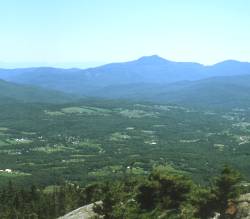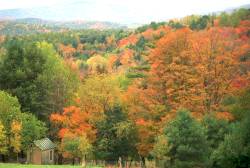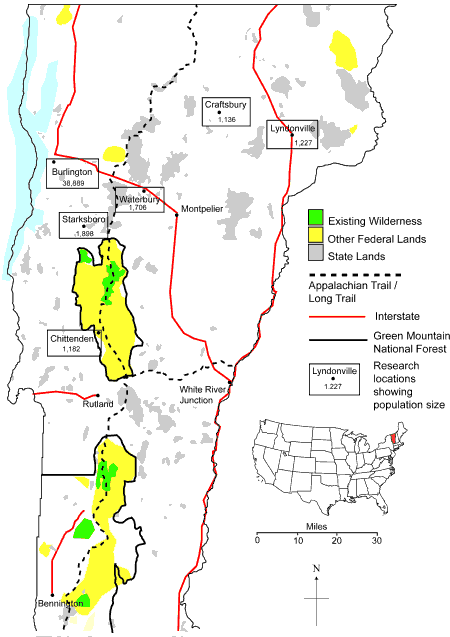Summary
What do people in Vermont, USA, appreciate about their trees and woods?
Summary

This three-month project involved group discussions and interviews with people in Vermont, USA, to find out how they valued trees and woods. The work also examined how public attitudes and use of woodlands affects how forestry and environmental organisations approach site conservation and management.
Key findings
Public perspectives
- Personal value: forests and trees are important to the public on a personal basis as a place to enjoy nature, recreational activities and escape from every day routines
- Economic value: awareness that Vermont’s forests attract money to the state and contribute to the state’s distinct character
- Education: in Vermont, individuals sometimes spoke of how their parents had passed down knowledge and skills about the environment, although education was not a topic that was often raised
- Comforting: forests in Vermont were often described as ‘comforting’ and ‘reassuring’ – they are so widespread the public seem to feel comfortable using and being in them
- Connection: close relationship between people’s views of forests and trees, everyday life and cultural identity
- Timber production: private landowners were viewed as having the right to manage as they saw fit as long as there was no extensive clear-cutting, but public land was valued for recreation and public access, and spiritual, aesthetic and personal well-being
Organisational perspectives
- Urban forests: realisation that the future of forestry may involve creating forests near to where people live to deliver social and community benefits
- Decision-making: public organisations struggle to involve the public in effective decision-making processes and are unable to build consensus among competing priorities of industry, recreation and conservation bodies
- Cultural change: state and federal forestry bodies have moved away from prioritising timber production and now take a wider view of the benefits that forests provide
- Conflict: while forestry organisations claim to be working for forest health and often for public interest, their focus and management objectives can be very different
- Creativity: the variety of organisations in Vermont concerned with forests and trees often think from very different perspectives, helping to bring a range of creative solutions to their work
Publications
Funders and partners
Joint funded by the Forestry Commission, Forest Research and the Scottish Forestry Trust.
Contact
Status
2002.
Social and cultural values of woods – Research in Vermont, USA – Organisational perspectives
Interviews were undertaken with representatives from diverse organisations in Vermont. These were chosen because they were able to give an overview of the current forestry situation in the state and to raise issues they considered to be important, relating to both public and private forests, how they were managed and for what purposes.
Professionals were interviewed from the:
- National Community Forestry Centre
- Northern Forest Centre
- Vermont Land Trust
- Forest Watch
- Greenleaf Forestry
- Vermont Family Forests
- Vermont Council on Rural Development
- Department of Forests, Parks and Recreation
- US Forest Service.
Key issues raised
There is an increasing realisation between forestry and environmental professionals in Vermont that the future of forestry may involve creating forests near to where people live, particularly in more urban settings. As one forester explained ‘small forests are a big deal’. If these forests are a resource for communities and if they provide a sense of ownership to people then they can have an important impact on local communities.
There was also an acknowledgement or realisation that in many ways state and federal organisations in Vermont are often still having difficulties involving the public in any sort of effective decision-making processes. One of the things that state and federal organisations find difficult is that there is no single agenda which they can tap into; rather, they have to deal with the competing factions of industry, recreation and conservation bodies.
State and federal forestry bodies in Vermont, like the Forestry Commission in Britain, have undergone cultural change within their respective organisations, with a move away from a focus dominated primarily by timber production objectives to a much wider view of the benefits that forests provide.
The institutional framing of issues surrounding the forests in Vermont is extremely important. While the organisations in this research all claim to be working for forest health and often for public interest, their focus and management objectives can be very different. What is clear is that the variety of organisations in Vermont concerned with forests and trees often think from very different perspectives and can bring a range of creative solutions to their work.
Social and cultural values of woods – Research in Vermont, USA – Public perspectives
 The aim of this work was to explore the ways in which people value trees and forests in Vermont, USA through a series of discussion groups and interviews.
The aim of this work was to explore the ways in which people value trees and forests in Vermont, USA through a series of discussion groups and interviews.
Vermont is a rural state with a high percentage of forest cover. The quality of the environment was seen as very important to the people of Vermont. Forests were important to people on a personal basis as somewhere they could go to enjoy nature. There was also an awareness of the importance of forests in attracting money to the state through tourism. Vermont is known for the autumn colours of its forests.
Why forests and trees are important to people
- Forests and trees are important to the public in Vermont on a personal basis as a place to enjoy nature, recreational activities and escape from every day routine life. There was also awareness of the importance of forests in attracting money to the state and in contributing to Vermont’s distinct character.
- In Vermont individuals sometimes spoke of how their parents had passed down knowledge and skills about the environment, although education generally was not a topic that was often raised.
- Forests in Vermont were often described as ‘comforting’ and ‘reassuring’. Because forests in the state are so widespread the public seem to feel comfortable using them and being in them.
- What emerged from the discussion groups was the close relationship between people’s views of forests and trees and the wider sense of what it meant to live in Vermont and the quality of its landscape. People’s views on this subject did not stand apart from the larger dimensions of their everyday lives. Concerns about forests and trees were woven into other discourses on the development of areas and subsequent loss of forest cover and the changes of cultural identity within the state.
- People’s views of timber production were different for public and private land. On private land, landowners were viewed as having the right to manage as they saw fit as long as there was no extensive clear-cutting. On public land, recreation and public access, spiritual, aesthetic and well-being values were viewed as more important than timber production.
Some of the concerns expressed in the groups about the wider environment included a worry that the states distinct character would be changed by development and sprawl as the population increases.
People in the groups realised the quality of the environment of their state and outlined the contradictions between wanting progress, easy access to the facilities and amenities of modern life and the importance of conserving a particular way of life.
Background
Discussion groups were held in six different locations within the state with people from different age groups and backgrounds. Vermont is a rural state with a small population. The forests cover in the state consists of:
- Northern Hardwoods – consisting of beech, birch and maple that occur all over the state below two and a half thousand feet
- Coniferous forests of spruce and fir at higher altitudes.

Map of Vermont showing research locations and its location within the USA
General Content
Related pages
- Social and cultural values of woodlands in northwest and southeast England
- Impact of trees for residents of Peabody Hill
- People, trees and woodlands
- Society and diversity in relation to trees, woods and forests
- Trees and woods for well-being and quality of life
